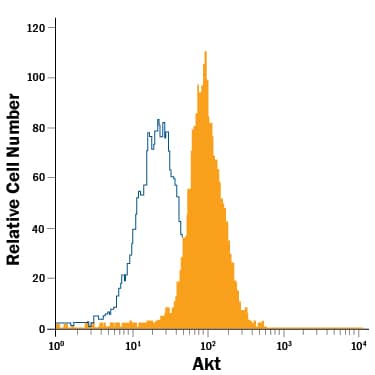Human/Mouse/Rat Akt Pan Specific APC-conjugated Antibody
R&D Systems, part of Bio-Techne | Catalog # IC2055A


Conjugate
Catalog #
Key Product Details
Species Reactivity
Human, Mouse, Rat
Applications
Intracellular Staining by Flow Cytometry
Label
Allophycocyanin (Excitation = 620-650 nm, Emission = 660-670 nm)
Antibody Source
Monoclonal Mouse IgG2B Clone # 281046
Product Specifications
Immunogen
E. coli-derived recombinant human Akt1
Ser2-Ala480
Accession # P31749
Ser2-Ala480
Accession # P31749
Specificity
Detects human, mouse and rat Akt in direct ELISAs and Western blots.
Clonality
Monoclonal
Host
Mouse
Isotype
IgG2B
Scientific Data Images for Human/Mouse/Rat Akt Pan Specific APC-conjugated Antibody
Detection of Akt in Jurkat Human Cell Line by Flow Cytometry.
Jurkat human acute T cell leukemia cell line was stained with Mouse Anti-Human/Mouse/Rat Akt Pan Specific APC-conjugated Monoclonal Antibody (Catalog # IC2055A, filled histogram) or isotype control antibody (Catalog # IC0041A, open histogram). View our protocol for Staining Intracellular Molecules.Applications for Human/Mouse/Rat Akt Pan Specific APC-conjugated Antibody
Application
Recommended Usage
Intracellular Staining by Flow Cytometry
10 µL/106 cells
Sample: Jurkat human acute T cell leukemia cell line
Sample: Jurkat human acute T cell leukemia cell line
Formulation, Preparation, and Storage
Purification
Protein A or G purified from hybridoma culture supernatant
Formulation
Supplied in a saline solution containing BSA and Sodium Azide.
Shipping
The product is shipped with polar packs. Upon receipt, store it immediately at the temperature recommended below.
Stability & Storage
Store the unopened product at 2 - 8° C. Do not use past expiration date. Protect from light.
Background: Akt
Additional Akt Products
Product Documents for Human/Mouse/Rat Akt Pan Specific APC-conjugated Antibody
Product Specific Notices for Human/Mouse/Rat Akt Pan Specific APC-conjugated Antibody
For research use only
